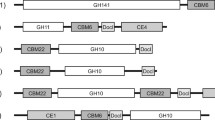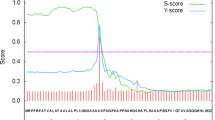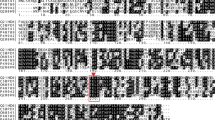Abstract
The fungus Penicillium purpurogenum grows on a variety of natural carbon sources and secretes a large number of enzymes which degrade the polysaccharides present in lignocellulose. In this work, the gene coding for a novel endoxylanase has been identified in the genome of the fungus. This gene (xynd) possesses four introns. The cDNA has been expressed in Pichia pastoris and characterized. The enzyme, XynD, belongs to family 10 of the glycoside hydrolases. Mature XynD has a calculated molecular weight of 40,997. It consists of 387 amino acid residues with an N-terminal catalytic module, a linker rich in ser and thr residues, and a C-terminal family 1 carbohydrate-binding module. XynD shows the highest identity (97%) to a putative endoxylanase from Penicillium subrubescens but its highest identity to a biochemically characterized xylanase (XYND from Penicillium funiculosum) is only 68%. The enzyme has a temperature optimum of 60 °C, and it is highly stable in its pH optimum range of 6.5–8.5. XynD is the fourth biochemically characterized endoxylanase from P. purpurogenum, confirming the rich potential of this fungus for lignocellulose biodegradation. XynD, due to its wide pH optimum and stability, may be a useful enzyme in biotechnological procedures related to this biodegradation process.









Similar content being viewed by others
References
Kabel, M. A., van den Borne, H., Vincken, J.-P., Voragen, A. G. J., & Schols, H. A. (2007). Structural differences of xylans affect their interaction with cellulose. Carbohydrate Polymers, 69(1), 94–105.
Sunna, A., & Antranikian, G. (1997). Xylanolytic enzymes from fungi and bacteria. Critical Reviews in Biotechnology, 17(1), 39–67.
Cantarel, B. L., Coutinho, P. M., Rancurel, C., Bernard, T., Lombard, V., & Henrissat, B. (2009). The carbohydrate-active EnZymes database (CAZy): an expert resource for glycogenomics. Nucleic Acids Research, 37(Database), D233–D238.
Collins, T. C., Gerday, C., & Feller, G. (2005). Xylanases, xylanase families and extremophilic xylanases. FEMS Microbiological Reviews, 29(1), 3–23.
Chávez, R., Schachter, K., Navarro, C., Peirano, A., Aguirre, C., Bull, P., & Eyzaguirre, J. (2002). Differences in expression of two endoxylanase genes (xynA and xynB) from Penicillium purpurogenum. Gene, 293(1-2), 161–168.
Belancic, A., Scarpa, J., Peirano, A., Díaz, R., Steiner, J., & Eyzaguirre, J. (1995). Penicillium purpurogenum produces several xylanases: purification and properties of two of the enzymes. Journal of Biotechnology, 41(1), 71–79.
Mardones, W., Di Genova, A., Cortés, M. P., Travisany, D., Maas, A., & Eyzaguirre, J. (2018). The genome sequence of the soft-rot fungus Penicillium purpurogenum reveals a high gene dosage for lignocellulolytic enzymes. Mycology: An International Journal of Fungal Biology, 9(1), 59–69.
Hidalgo, M., Steiner, J., & Eyzaguirre, J. (1992). Beta-glucosidase from Penicillium purpurogenum: purification and properties. Biotechnology and Applied Biochemistry, 15(2), 185–191.
Yin, Y., Mao, X., Yang, J., Chen, X., Mao, F., & Xu, Y. (2012). dbCAN: a web resource for automated carbohydrate-active enzyme annotation. Nucleic Acids Research, 40(W1), W445–W451.
Zavaleta, V., & Eyzaguirre, J. (2016). Penicillium purpurogenum produces a highly stable endo-β-(1,4)-galactanase. Applied Biochemistry and Biotechnology, 180(7), 1313–1327.
Miller, G. L. (1959). Use of dinitrosalicylic acid reagent for determination of reducing sugar. Analytical Chemistry, 31(3), 426–428.
Furniss, C. S. M., Williamson, G., & Kroon, P. A. (2005). The substrate specificity and susceptibility to wheat inhibitor proteins of Penicillium funiculosum xylanases from a commercial enzyme preparation. Journal of the Science of Food and Agriculture, 85(4), 574–582.
Dimarogona, M., Topakas, E., Christakopoulos, P., & Chrysina, E. D. (2012). The structure of a GH10 xylanase from Fusarium oxysporum reveals the presence of an extended loop on top of the catalytic cleft. Acta Crystallographica Section D, Biological Crystallography, 68(7), 735–742.
Kupfer, D. M., Drabenstot, S. D., Buchanan, K. L., Lai, H., Zhu, H., Dyer, D. W., Roe, B. A., & Murphy, J. W. (2004). Introns and splicing elements of five diverse fungi. Eukaryotic Cell, 3(5), 1088–1100.
Yin, X., Gong, Y.-Y., Wang, J.-Q., Tang, C.-D., & Wu, M.-C. (2013). Cloning and expression of a family 10 xylanase gene (Aoxyn10) from Aspergillus oryzae in Pichia pastoris. Journal of General and Applied Microbiology, 59(6), 405–415.
Kishishita, S., Yoshimi, M., Fujii, T., Taylor II, L. E., Decker, S. R., Ishikawa, K., & Inoue, H. (2014). Cellulose-inducible xylanase Xyl10A from Acremonium cellulolyticus: purification, cloning and homologous expression. Protein Expression and Purification, 94, 40–45.
Fan, G., Yang, S., Yan, Q., Guo, Y., Li, Y., & Jiang, Z. (2014). Characterization of a highly thermostable glycoside hydrolase family10 xylanase from Malbranchea cinnamomea. International Journal of Biological Macromolecules, 70, 482–489.
Biely, P., Vrsanska, M., Tenkanen, M., & Kluepfel, D. (1997). Endo-β-1,4-xylanase families: differences in catalytic properties. Journal of Biotechnology, 57(1-3), 151–166.
Ribeiro, L. F. C., De Lucas, R. C., Vitcosque, G. L., Ribeiro, L. F., Ward, R. J., Rubio, M. V., Damásio, A. R. L., Squina, F. M., Gregory, R. C., Walton, P. H., Jorge, J. A., Prade, R. A., Buckeridge, M. S., & Polizeli, M. d. L. T. M. (2014). A novel thermostable xylanase GH10 from Malbranchea pulchella expressed in Aspergillus nidulans with potential applications in biotechnology. Biotechnology for Biofuels, 7(1), 115.
Funding
This work has been supported by grants from FONDECYT (1130180) and Universidad Andrés Bello (DI-478-14/R and DI-31-12/R).
Author information
Authors and Affiliations
Corresponding author
Ethics declarations
Conflict of Interest
The authors declare that they have no competing interests.
Rights and permissions
About this article
Cite this article
Echeverría, V., Eyzaguirre, J. Penicillium purpurogenum Produces a Set of Endoxylanases: Identification, Heterologous Expression, and Characterization of a Fourth Xylanase, XynD, a Novel Enzyme Belonging to Glycoside Hydrolase Family 10. Appl Biochem Biotechnol 187, 298–309 (2019). https://doi.org/10.1007/s12010-018-2782-7
Received:
Accepted:
Published:
Issue Date:
DOI: https://doi.org/10.1007/s12010-018-2782-7




